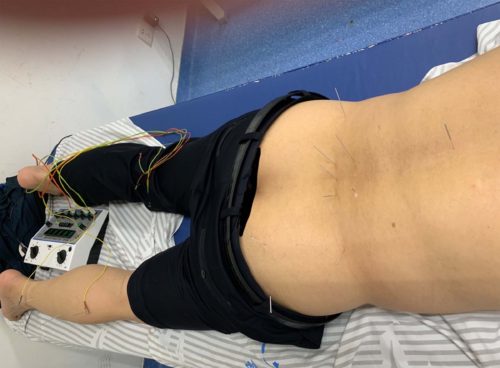When it comes to getting pregnant, old-world techniques may be just what today’s high-tech doctors will order.
By: John Lally Lic.AC.TCM, Clin.AC, Clinic Director

A patient receiving electro acupuncture for back pain
Chronic Back Pain is one of the most common reasons people seek medical attention. It has been estimated that up to 80% of the world’s population will suffer from back pain at some point in their lives, with the lower back as the most common location of the pain.
Though most occurrences of back pain last less than two weeks, research has shown that recurrence rates for low back pain can reach as high as 50% in the first few months following the first episode.
Why Use Acupuncture for Back Pain?
The use of acupuncture to treat back pain has increased dramatically in the past few decades, based to a large degree on placebo-controlled studies that have validated it as a reliable method of back pain relief. The results of a recent study published in the Clinical Journal of Pain provide further proof that acupuncture is a safe and effective treatment for low-back pain, and that acupuncture can maintain positive outcomes for periods exceeding six months or longer without producing the negative side-effects that often accompany more traditional pain remedies such as anti-inflammatory steroids or pain medication.
TCM (Traditional Chinese Medicine) Definitions of Back Pain
Kidney Chi Deficiency
According to Traditional Chinese Medicine theory, the Kidney and Bladder Acupuncture Meridian governs the back. When there is a deficiency in Kidney Yin or Kidney Yang this may have a negative effect on the Acupuncture channels on the posterior of the body resulting in weakness, stiffness, and/or pain in the back.
Liver Chi Stagnation
The body’s Chi (Vital Energy) must flow freely for abundant health. In TCM the Liver organ governs the free flow of Chi in all areas of the body including the upper and lower back. Any impediment to the free flow of energy in the back will result in moderate pain and stiffness. As the Liver organ in TCM is closely associated with emotions such as stress, frustration, and anger – we would often observe case histories where back pain is triggered or exacerbated by emotional triggers such as premenstrual syndrome.
Blood Stagnation in the Lower Back
A severe form of Chi stagnation (above) blood stagnation or blood stasis in the lower back can result in severe stabbing pain on movement or rest. This is a result of long term Chi stagnation which eventually causes the flow of blood in the affected area to effectively become stuck. As in TCM theory, the Chi (especially Liver Chi) moves blood in the acupuncture channels – any impediment to the free flow of Chi results in internal “friction” which almost often transforms into severe pain and stiffness. Blood stagnation in the lower back may form as a result of physical issues such as an injury due to a fall, impact, exposure to cold wind or overwork, and emotional issues such as long term stress.
Invasion of Wind-Cold
According to Acupuncture theory, the Kidneys are susceptible to invasion of wind-cold or damp cold. This occurs when the lower back is frequently exposed to cold or damp weather resulting in depletion of the kidney Yang energies and as cold obstructs movement the eventual stagnation of Chi in the affected area. The invasion of cold may be accompanied by symptoms such as the feeling of cold, tightness in the lower back, frequent urination, and low energy.
Common Medical Causes of Back Pain
Lumbar Muscle Strain
Muscle strains are the most common cause of low back pain. Patients may or may not remember the initial event that triggered their muscle spasm, but the good news is that most episodes of back pain from muscle strains resolve completely within a few weeks.
Ruptured Disc
A ruptured intervertebral disc also called a herniated disc, is another common cause of back pain. How to treat the back pain from a herniated disc depends on the particular individual and situation.
Discogenic Back Pain
Discogenic back pain is thought to be a common cause of low back pain. Discogenic back pain is the result of damage to the intervertebral disc but without disc herniation. Diagnosis of discogenic back pain may require the use of a discogram.
Spinal Stenosis
Spinal stenosis causes back pain in the aging population. As we age, the spinal canal can become constricted, due in part to arthritis and other conditions. If the spinal canal becomes too tight, back pain can be the result.
Lumbar Spine Arthritis
Arthritis most commonly affects joints such as the knees and fingers. However, arthritis can affect any joint in the body, including the small joints of the spine. Arthritis of the spine can cause back pain with movement.
Spondylolisthesis
Spondylolisthesis causes back pain because the adjacent vertebra becomes unstable and begins to “slip.” The most common cause of spondylolisthesis is due to degenerative changes causing loss of the normal stabilizing structures of the spinal column. If the spine becomes unstable enough, back pain can become a problem.
About the Author: John Lally Lic.AC.TCM, Clin.AC is the clinic director at the Blue Heron Acupuncture Clinic in Galway, Ireland and is a member of the Acupuncture Foundation Professional Association of Ireland and the European Traditional Chinese Medicine Association (ETMCA)